June 6, 2019 feature
Polarization-encryption based data storage in 3-D Janus plasmonic helical nanoapertures
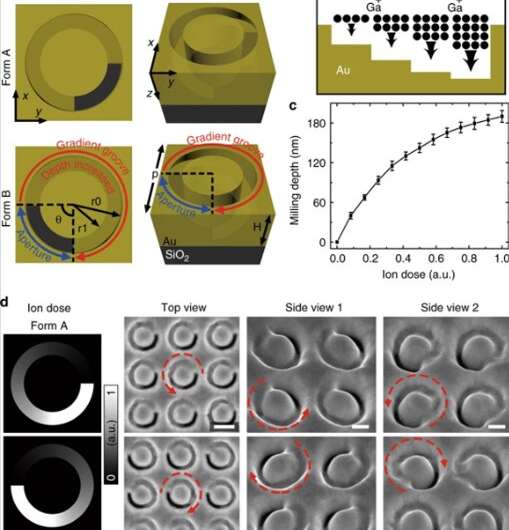
Helical plasmonic nanostructures have attracted considerable attention in materials science and chemistry due to their inherent optical chirality. In a new report, Yang Chen and a research team in the department of Mechanical and Aerospace Engineering in the U.S. developed unique 3-D Janus (nanoparticles with two or more surface properties) plasmonic helical nanoapertures (helical holes), with direction-controlled polarization sensitivity. They engineered the helical structures using one-step grayscale focused ion beam milling (FIB). Chen et al. then encoded the Janus metasurface with two nanoaperture enantiomers (left and right handed mirror image molecules of each other) with specific rotational angles to demonstrate direction-controlled polarization data encryption for the first time.
The samples engineered in the work allowed the selective transmission of certain types of polarized light, while blocking others. This sensitivity to polarization depended on the direction of the incoming light; for instance, light in a specific direction prompted the arrays to produce binary images, whereas light in the opposite direction could reproduce grayscale photographs. Chen et al. envision using the proposed Janus helical nanoapertures for a variety of applications ranging from polarization control within built in photonic devices, advanced enantiomer sensing, data encryption and decryption as well as optical information processing. The new results are now published in Light: Science & Applications.
Chirality was first defined by Lord Kelvin to describe any geometrical figure whose mirror image could not coincide with itself. The property is ubiquitous in biological objects that range from small biomolecules such as amino acids and nucleotides to larger macromolecules such as proteins and nucleic acids, and even our hands and feet. While the left-handed and right-handed versions of a molecule known as enantiomers can have similar chemical and physical properties, they can perform entirely different biological functions in diverse fields of applications.
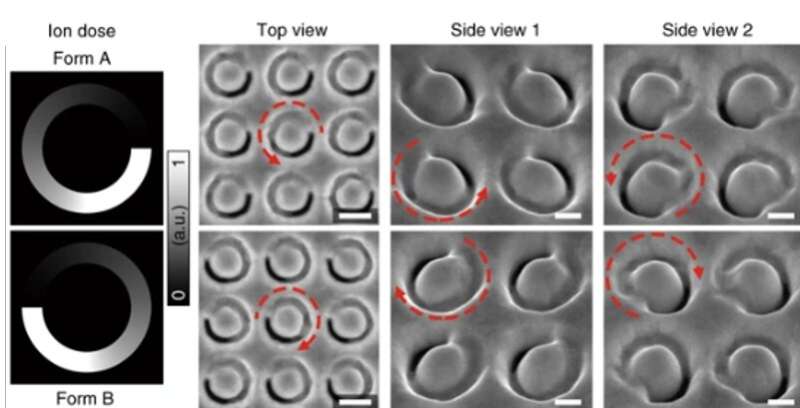
Circular dichroism (CD) spectroscopy is typically used to analyze the chiroptics of two enantiomers, but chiroptical effects are extremely weak in natural materials. To overcome this challenge, scientists previously developed chiral plasmonic structures to significantly boost CD signals of chiral molecules. Aside from this purpose, such structures also have additional applications as miniature polarizers, nonlinear optics and spin-controlled optical devices. Helical plasmonic nanostructures are important since the electric field vector of circularly polarized light (CPL) can follow a helical trajectory. As a result, strong light matter interactions are expected when the handedness of helical nanostructures match that of CPL. However, it is challenging to fabricate such helical nanostructures in practice.
Materials scientists have previously used two-photon direct laser writing followed by an electroplating step to produce a 3-D plasmonic helix, which had spatial resolution limits at the microscale during applications in the visible and near-IR spectrum. Similarly, focused electron/ion-beam induced deposition could scale the helical structure to the nanostructure, but the method lacked speed for large-scale production. As a consequence, lithography facilities with high-resolution alignment and delicate operations are presently required in order to conveniently and rapidly fabricate plasmonic helical nanostructures with giant CD signals.
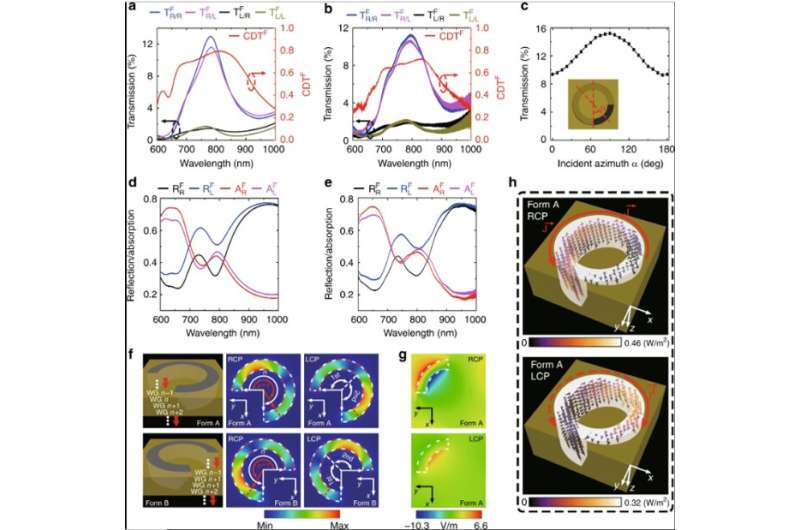
In the present work, Chen et al. etched the 3-D Janus plasmonic helical nanoapertures on a single, optically thick gold film with an arc shaped aperture and arc shaped gradient groove connected end-to-end with each other. Based on the depth of the gradient groove, which was increased either clockwise or counterclockwise, the chiral helical nanoapertures existed in two enantiomeric forms as versions "A' and "B' that were mirror symmetric to each other. The scientists applied a high dose of Ga+ ions during the process of focused ion beam milling and delicately adjusted the focus and astigmatism of the ion beam to form the 3-D helical nanoaperture arrays with satisfactory uniformity.
They then studied the chiroptical properties of 3-D plasmonic helical nanoapertures in the forward direction, when the circularly polarized light (CPL) was illuminated onto the gold surface and transmitted out from the silica substrate within the experimental setup. The numerical simulation conducted with COMSOL Multiphysics and the experimental results of the study coincided with each other, and Chen et al. credited any experimental discrepancies to fabrication imperfections in the FIB system.
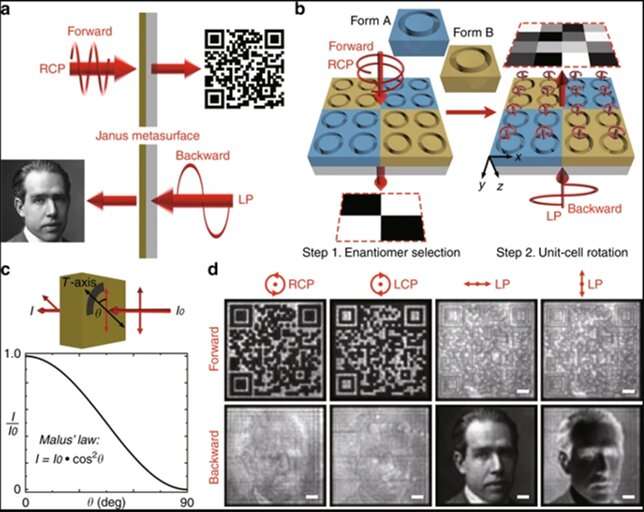
The scientists modeled the 3-D helical nanoapertures as a series of cascaded arc-shaped waveguide segments to achieve the expected optical chirality. If the handedness of the CPL (circularly polarized light) matched that of the gradient groove, the incoming optical power could be collected into the aperture area along the gradient groove to produce a strong transmission in the experimental setup.
Chen et al. then determined the optical properties of the 3-D Janus plasmonic helical nanoaperture in the backward direction. For this, they illuminated the light into the silica substrate to transmit it out from the gold surface to obtain almost similar intensity in the backward direction, the results showed giant linear dichroism (not circular dichroism) with circularly polarized light.
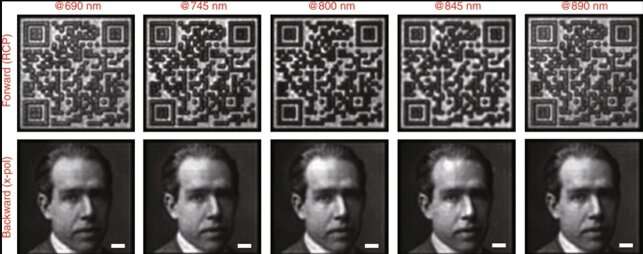
Based on these results, Chen et al. encoded the Janus metasurface to construct a binary QR (quick response) code image in the forward direction under right-handed circularly polarized (RCP) illumination. In the second step, they encoded a grayscale image in the backward direction under linearly polarized light. They were able to encode information onto the same Janus metasurface without mutual disturbance and reveal the QR code image when only illuminating the right-handed light in the forward direction to decrypt and connect to an encoded message linking the Wikipedia site of the physicist Niels Bohr. Chen et al. tested the broadband performance of the Janus metasurface to distinguish the QR code image using a QR code scanner at 690 nm, ranging up to 890 nm.
In this way, Chen et al. introduced a new type of 3-D Janus plasmonic nanoaperture using direction-switched polarization sensitivity. They fabricated the device using one-step grayscale FIB milling. The unique optical properties of the 3-D helical nanoapertures allowed them to encrypt and decrypt data using direction-controlled light polarization. The work will have additional, next-generation applications as multifunctional polarizers, high-resolution displays and in optical information processing.
More information: Yang Chen et al. 3-D Janus plasmonic helical nanoapertures for polarization-encrypted data storage, Light: Science & Applications (2019). DOI: 10.1038/s41377-019-0156-8
William Thomson et al. Baltimore Lectures on Molecular Dynamics and the Wave Theory of Light, (2012). DOI: 10.1017/CBO9780511694523
Shengyan Yang et al. Spin-Selective Transmission in Chiral Folded Metasurfaces, Nano Letters (2019). DOI: 10.1021/acs.nanolett.8b04521
Journal information: Light: Science & Applications , Nano Letters
© 2019 Science X Network




















